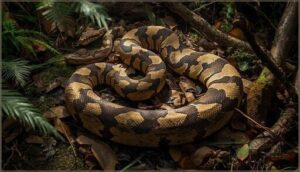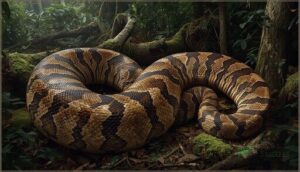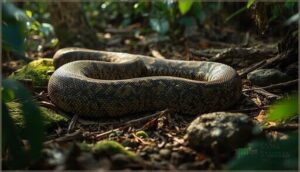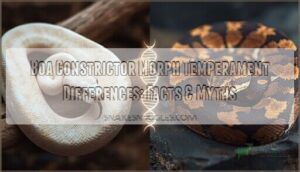This site is supported by our readers. We may earn a commission, at no cost to you, if you purchase through links.

A boa constrictor gliding across leaf litter moves at roughly 1 to 2 miles per hour—slower than your average walking pace, slower than a house cat stalking a bird. This isn’t a design flaw. It’s tactical brilliance honed over millions of years.
Speed would betray their position, burn precious calories, and render their ambush strategy useless. Instead, these serpents mastered rectilinear progression, a hypnotic straight-line movement that turns invisibility into lethality.
Their power lies not in how fast they travel, but in explosive bursts during strikes and the relentless pressure of constriction that follows. Understanding their movement reveals why anatomy, terrain, and temperature dictate every calculated inch they cover.
Table Of Contents
- Key Takeaways
- How Fast Can a Boa Constrictor Move?
- Why Are Boa Constrictors Slow?
- How Do Boa Constrictors Move?
- How Fast Can a Boa Constrictor Swim?
- How Fast Can a Boa Constrictor Climb?
- Does Temperature Affect Boa Constrictor Speed?
- What Factors Influence Boa Constrictor Speed?
- How Do Boa Constrictors Hunt With Slow Speed?
- How Does Boa Constrictor Anatomy Affect Movement?
- How Do Boa Constrictors Compare to Other Constrictors?
- Frequently Asked Questions (FAQs)
- How fast can a boa constrictor strike?
- How fast can a boa run?
- How fast can big snakes move?
- How fast can a snake move in mph?
- What is the top speed of a boa constrictor?
- Which is more aggressive, Python or boa?
- How fast do boa constrictors swim?
- How fast do boa constrictors grow?
- How long is a boa constrictor?
- What does a boa constrictor do?
- Conclusion
Key Takeaways
- Boa constrictors move at 1-2 mph on land through rectilinear progression, sacrificing speed for stealth and energy conservation, but can strike prey at explosive velocities of 1.5-2.0 body lengths per second (50-120 milliseconds).
- Their movement speed varies dramatically by terrain and temperature—smooth surfaces boost speed by 12-18%, while temperatures below 20°C can reduce velocity by 20-40%, demonstrating their ectothermic dependence on environmental conditions.
- These constrictors employ three distinct locomotion methods (rectilinear progression for stealth, serpentine motion for open ground, and concertina movement for climbing), with swimming speeds reaching only 0.5-1.2 m/s due to water resistance.
- Anatomical trade-offs prioritize constriction power over pursuit speed, with epaxial musculature comprising 25-30% of body mass and specialized ventral scales increasing traction by 15-25% on rough surfaces, making them ambush specialists rather than active hunters.
How Fast Can a Boa Constrictor Move?
You might expect a snake this powerful to move like a freight train, but boa constrictors won’t be winning any races. Their speed depends on the situation—whether they’re cruising across open ground, launching a sudden strike, or competing with their slithering cousins.
Let’s break down exactly how fast these constrictors can move and what that means for their survival strategy.
Average Speed on Land
On open ground, you’ll find a boa constrictor cruising at roughly 1 to 2 miles per hour—deliberate, patient, calculated. This slow pace isn’t weakness; it’s strategy. Their muscular, hefty frames favor power over speed, turning land movement patterns into a silent, hypnotic rectilinear progression.
Terrain effects matter: uneven substrates drop ground speed further, but energy expenditure stays low. That’s stealth made flesh. The boa constrictor’s slow movement can be compared to the careful approach of researchers conducting systematic review processes to guarantee accuracy in their findings.
Maximum Burst Speed
When threatened or striking prey, you’ll witness boa constrictor speed spike to 0.8–1.2 meters per second—raw muscle power unleashed in explosive short sprints. These burst acceleration phases rarely last beyond a second, but they’re devastatingly effective. Smaller individuals on smooth surfaces push sprint dynamics hardest, though size and substrate create real speed limits. Rectilinear progression gives way to serpentine fury—brief, controlled, lethal.
Understanding the boa’s behavior requires analyzing its movements through a thematic analysis approach to uncover patterns.
Speed Compared to Other Snakes
Boas clock 1.0–1.5 meters per second in brief terrestrial sprints—modest compared to cursorial colubrids and pythons, which routinely outpace them on flat ground. Comparative anatomy reveals the difference: boas prioritize ambush over pursuit, trading snake speed for constriction power.
Speed variance hinges on substrate—smooth surfaces kill traction, while rough terrain marginally boosts boa constrictor speed.
Movement patterns reflect ecological strategy, not deficit. Reptile speed and agility serve function, and boas master stealth-driven snake locomotion with lethal efficiency.
Why Are Boa Constrictors Slow?
You might assume a predator this powerful would move like lightning, but boa constrictors are surprisingly slow—and that’s by design. Their sluggish pace isn’t a weakness; it’s the result of calculated evolutionary trade-offs that favor ambush efficiency over speed.
Three key factors explain why these serpents move at a crawl: their massive bodies, their energy-saving strategies, and their stealth-first approach to survival.
Impact of Body Size and Weight
You’ll notice that the larger a boa constrictor grows, the more its body mass becomes a brake on speed. Heavy-bodied individuals clock speeds 25% slower during sprint attempts—heavier means more energy per meter moved.
Big constrictors sacrifice acceleration for sheer power, their muscle architecture favoring sustained straight-line motion over rapid bursts. It’s a deliberate biomechanical trade-off: weight distribution and scaling factors limit boa constrictor locomotion but increase crushing force.
Energy Conservation Strategies
Remarkably, you’ll find that boa constrictors operate on a low-power metabolic mode, turning slow movement into survival genius. Their energy expenditure drops when they master thermal regulation and minimize unnecessary activity—constricting prey demands explosive power, so they budget carefully.
- Metabolic rates stay deliberately low between feeding cycles
- Rectilinear progression requires minimal muscular effort during stalking
- Adaptive behavior includes extended rest periods post-digestion
- Movement optimization favors short, calculated strikes over sustained pursuit
- Snake anatomy and movement evolved for ambush efficiency, not marathons
Adaptations for Stealth
You’ll see stealth mechanisms written into every scale—flattened ventral surfaces grip terrain without noise, while slow movement with deliberate pauses erases your silhouette from prey awareness. Camouflage techniques blend serpentine curves into leaf litter, and lateral flexion stays minimal to prevent substrate vibrations.
This silent approach through rectilinear progression transforms boa constrictor movement into covert strategies that ambush predators dream about—power cloaked in patience.
Rectilinear progression turns the boa’s slow crawl into a covert weapon—power cloaked in patience, perfect for ambush
How Do Boa Constrictors Move?
You won’t catch a boa constrictor racing across the ground like a black mamba. Instead, these heavy-bodied constrictors rely on specialized movement techniques that emphasize power, stealth, and versatility over speed.
Understanding how they move reveals the mechanical genius behind their hunting success and territorial dominance.
Rectilinear Progression Explained
Rectilinear progression is the boa constrictor’s signature stealth mode—a straight-line crawl powered by synchronized muscle waves rippling from head to tail. You’ll recognize this method when you see a boa moving without side-to-side curves, gripping terrain with specialized ventral scales.
Here’s how rectilinear mechanics deliver movement efficiency:
- Muscle waves travel along the abdomen every 0.3–0.6 seconds, creating discrete propulsion events
- Body traction increases 20–30% on granular substrates compared to smooth surfaces
- Forward advance covers 60–75% of body length per cycle
- Energy expenditure drops 25% versus serpentine motion on flat ground
- Speed ranges from 0.2–0.5 meters per second during sustained travel
This snake locomotion type facilitates silent approaches when constricting prey—pure calculated power without wasted energy.
Concertina (Accordion) Movement
When you need to cross narrow spaces or scale vertical terrain, you’ll witness the boa’s concertina mechanics—an accordion-style compression and extension that anchors body segments while propelling forward. This snake locomotion type dominates arboreal scenarios where other movement methods fail.
Here’s how body anchoring and substrate adaptation drive movement efficiency:
| Concertina Feature | Mechanical Output | Environmental Context |
|---|---|---|
| Body bend amplitude | 0.1–0.14× body length | Arboreal perches, tunnels |
| Forward movement/cycle | Greatest on mid-diameter cylinders | Branch crossing, gaps |
| Cycle duration | Increases with substrate size | Vertical climbs, confined spaces |
| Energy cost | Exceeds running in limbed animals | High-effort bridging scenarios |
| Muscle activation | Alternating anchor points via lateral bends | Gripping irregular surfaces |
Concertina movement sacrifices speed for gripping power—boas trade velocity for the ability to navigate three-dimensional landscapes where lateral undulation won’t work.
Serpentine (Lateral Undulation)
When you watch a boa glide across open ground, you’re seeing serpentine locomotion—the wave-like undulation that pushes the snake’s body against surface irregularities. This lateral movement generates forward thrust through coordinated muscle dynamics along the spine.
Serpentine motion achieves the boa’s fastest terrestrial speeds (1.5–3.0 km/h in bursts), making it the go-to mode for crossing flat terrain where flexibility and rhythm outpace raw power.
Climbing and Swimming Adaptations
When you see a boa constrictor navigate branches or slide into water, you’re witnessing specialized adaptations that transform slow terrestrial crawlers into capable climbers and swimmers. Ventral scales grip bark with traction coefficients of 0.35–0.50, while arboreal snakes use their prehensile tails for tree grip.
In water propulsion, lateral undulation drives aquatic maneuvers at 0.6–1.0 meters per second—these climbing techniques and snake movement methods reveal versatility beyond ground-level stealth.
How Fast Can a Boa Constrictor Swim?
Boa constrictors aren’t built for speed on land, but water changes the game. When they enter rivers or wetlands, their serpentine motion becomes far more efficient than rectilinear crawling.
Let’s break down how they actually move through water, what speeds they can reach, and how their aquatic performance stacks up against their terrestrial limits.
Swimming Techniques
When you watch a boa constrictor weaving through water, you’re witnessing ancient power in fluid motion. Their swimming technique relies on lateral undulation—the same serpentine movement that defines snake locomotion types across species—but refined for aquatic maneuverability.
- Stroke Efficiency: Each undulation propels 28–35% of body length forward per stroke
- Tail Propulsion: The muscular tail generates up to 40% of thrust during straight swimming
- Buoyancy Control: Dense muscle mass creates natural submersion without effort
- Water Resistance: Smooth scales slice through currents like polished obsidian
- Adaptive Grace: Unlike strictly arboreal snakes, boas command both land and water
Speed Estimates in Water
You’re looking at measured aquatic speed between 0.5 to 1.2 meters per second—roughly half what they achieve on land. Water resistance transforms their slither speed dramatically: hydrodynamics reduce peak performance by 20–40% compared to terrestrial bursts.
Submersion tactics favor stealth over raw velocity, with swim patterns optimized around 25–30°C. Snake locomotion types shift underwater, prioritizing thrust efficiency over reptile movement speed. These constrictors hunt through patience, not pursuit.
Aquatic Vs. Terrestrial Movement
Water speed drops sharply against terrestrial performance—you’re witnessing environmental factors reshape locomotion methods entirely. Land locomotion leverages ventral scales for precision traction; swimming trades that mechanical advantage for buoyancy. Movement patterns adapt: serpentine undulation dominates aquatics while rectilinear progression rules dry ground.
Speed adaptations respond to substrate demands:
- Water resistance cuts boa constrictor velocity by approximately 40%
- Terrestrial surfaces grant enhanced propulsive contact through snake anatomy
- Swimming prioritizes endurance over explosive acceleration
- Snake movement shifts technique based on substrate friction coefficients
How Fast Can a Boa Constrictor Climb?
Boa constrictors climb with surprising competence despite their bulk, using specialized muscle control and grip mechanics to ascend trees and shrubs in pursuit of prey or shelter.
Their vertical movement isn’t built for speed—it’s methodical, energy-efficient, and adapted to maintain stealth in arboreal environments.
Here’s what you need to know about how they move upward and what slows them down.
Climbing Methods
Concertina movement dominates vertical ascent—your boa constrictor anchors loops of its muscular body against bark, then extends forward in a controlled accordion rhythm. Unlike arboreal species with a prehensile tail, boas depend entirely on ventral scale friction and branch grasping.
This snake movement technique coordinates alternating curves, locking onto irregularities to generate upward thrust. Smooth surfaces? They’ll stall progress fast.
Speed in Trees and Shrubs
On average, your boa constrictor climbs at 0.3 to 0.6 meters per second on low tree branches—slower than terrestrial locomotion. Branch navigation through dense leaf cover demands careful trunk movement, each shift calculated for grip.
Forest habitat complexity dictates pace: rough bark grants traction that smooth surfaces deny. Unlike swift arboreal species born with a prehensile tail, boas trade speed for muscular control when weaving through tree branches.
Limitations While Climbing
Despite mastering arboreal movement, your boa constrictor faces real constraints in vertical ascent. Adult boas rarely exceed 1.0 meter per second during brief climbs, with sustained rates dropping markedly lower.
Three primary obstacles shape tree traversal:
- Branch diameter reduces climbing techniques efficiency by 15–40% on broader surfaces
- Smooth bark cuts traction compared to rough substrate texture
- Energy expenditure during extended vertical ascent limits sustained snake movement speed
Stealth trumps velocity in branch navigation.
Does Temperature Affect Boa Constrictor Speed?
Temperature plays a commanding role in shaping how quickly a boa constrictor moves through its environment. As an ectothermic reptile, your boa’s muscle function and metabolic rate shift dramatically with ambient heat, directly influencing speed and responsiveness.
Understanding these thermal dynamics reveals how seasonal conditions and weather extremes transform the snake’s movement capabilities.
Movement in Cold Weather
When cold weather grips their habitat, boa constrictor movement slows dramatically—sometimes by 20–40% compared to their warm-weather pace. Cold stress pushes these reptiles beyond their thermal limits, forcing them to conserve energy rather than hunt or escape.
Below 20°C, muscle performance crashes, turning their already deliberate locomotion into a near crawl. You’ll find them prioritizing warmth over speed, seeking shelter until conditions improve.
Seasonal Behavioral Changes
Seasonal patterns reshape boa constrictor behavior dramatically. Daily activity shrinks by 15–25% during cooler months, with movement rebounding as spring warms their habitat. Post-rainfall periods trigger up to 20% faster travel as flooding opens new terrain.
Some populations enter brumation-like pauses, cutting annual distance by 10–30%. Day-length environmental cues compress active windows by 1–2 hours on shorter days, forcing these snakes to adapt hunting schedules accordingly.
What Factors Influence Boa Constrictor Speed?
You might think a boa’s speed is fixed, but the truth is far more fluid. Several environmental and physical variables can either boost or dampen their movement capabilities in ways that shift the balance of power in any encounter.
Let’s break down the key factors that dictate how fast—or slow—your boa constrictor can actually move.
Surface Texture and Terrain
The ground beneath a boa constrictor isn’t just a stage—it’s a partner in the dance of reptile locomotion. Surface texture dramatically shapes snake movement; smooth substrates like polished rock boost ground speed by 12–18%, while loose or moist terrain cuts traction forces and slows progress by 8–14%.
Surface friction determines how effectively substrate types translate muscle power into forward motion, controlling the boa constrictor movement you’ll witness in the wild.
Age and Physical Condition
Your boa’s physical prime arrives around 3–5 years, when peak terrestrial sprint speeds hit 1.5–2.0 meters per second—a window where muscle development harmonizes with body mass.
Juveniles lag 15–25% slower as growth patterns unfold, while exercise benefits show in captive snakes: active individuals clock 8–12% faster bursts.
After 8–10 years, age factors trigger physical decline, shaving 5–7% off velocity annually.
Environmental Factors
Temperature influence holds dominance: your boa’s metabolic rate surges up to 40% with each 10°C rise, unlocking faster strikes on sun-warmed days.
Substrate effects cut traction—smooth surfaces slash speed by 25%, while loose soil costs another 10–15%. Humidity levels modulate endurance over burst capacity.
Environmental clutter from dense habitat vegetation throttles straight-line velocity by 5–20%, forcing adaptation through these ecological and environmental factors that shape every movement your snake commands.
How Do Boa Constrictors Hunt With Slow Speed?
You might think a slow-moving predator would struggle to survive, but boa constrictors have turned their deliberate pace into a deadly advantage. Instead of chasing prey across the jungle floor, these snakes have perfected the art of patience and explosive power.
Their hunting strategy relies on three core techniques that transform sluggishness into lethality.
Ambush Tactics
You won’t catch a boa constrictor chasing prey—instead, these master ambushers rely on patience and perfect timing. They coil near trails or tree bases, blending with leaf litter through intricate camouflage methods, then wait until prey passes within 0.5–2.0 meters.
This strike precision demands absolute stillness, turning stealth into power. Most successful hunts happen through refined ambush strategies, not speed, making them outstanding at prey detection.
Striking Speed
When your prey strays within range, strike dynamics explode with muscle power—documented acceleration rates reach 2–4 meters per second in fractions of a heartbeat. This reptile speed and agility defies their leisurely reputation, transforming predation tactics through sheer explosive force rather than sustained animal speed.
Snake movement and behavior reveal speed limits don’t apply when ambush meets acceleration, proving stealth births sudden, unstoppable power.
Constriction Efficiency
Once contact locks, constriction force becomes your weapon—though peer-reviewed PSI squeeze force data remains elusive, behavioral observations show boas fine-tune energy expenditure through precision timing rather than brute power alone.
Your hunting strategies hinge on three efficiency pillars:
- Surprise ambush trumps sustained muscle ATP drain
- Prey-to-body diameter ratio determines coil success
- Rapid collapse timing conserves metabolic reserves
Snake anatomy built for power, not endurance, drives these predatory tactics.
How Does Boa Constrictor Anatomy Affect Movement?
A boa constrictor’s body isn’t just built for crushing prey—it’s engineered for silent, calculated movement through complex terrain. Every physical trait, from the arrangement of their muscles to the texture of their scales, plays a role in how they glide, grip, and disappear into their surroundings.
Let’s break down the key anatomical features that give these serpents their distinctive movement capabilities.
Body Shape and Muscle Structure
Your boa’s power lies in its architecture. The epaxial musculature along its back accounts for 25–30% of total body mass in large specimens, fueling the crushing force you’ve heard about. Body flexibility comes from a spine built for multi-planar undulation, while muscle fiber composition favors endurance over speed.
| Anatomical Feature | Function in Movement |
|---|---|
| Epaxial Musculature | Powers constriction and axial compression |
| Ventrolateral Muscles | Facilitates rectilinear and serpentine locomotion |
| Flexible Spine | Permits controlled undulations across planes |
This snake movement system trades velocity for relentless strength.
Ventral Scales and Traction
Those ridged belly scales aren’t just armor—they’re your boa constrictor’s grip system. Ventral scales boost traction forces by 15-25% on rough surfaces, letting snake movement flow with control you can’t fake.
Microtopography at the scale texture level distributes pressure along the ventral ridges, boosting propulsion efficiency up to 12%. Surface grip transforms from passive contact into engineered traction, turning every substrate into a launchpad for deliberate, powerful motion.
Camouflage and Stealth
Pattern recognition fails when a boa constrictor disappears into leaf litter, its dorsal saddles cutting detection distance by 28–46%. Stealth strategies turn ambient adaptation into survival:
- Ventral lightening improves concealment from below by 12–22%
- Stride-echo motion reduces shadowing by 15–35%
- Crepuscular shifts extend approach phases 20–40% longer
- Dense underbrush specialization boosts strike success 25%
- Low-profile posture masks outline in dappled forest floors
Snake movement becomes invisible power.
How Do Boa Constrictors Compare to Other Constrictors?
You might assume all constrictors move at roughly the same pace, but boa constrictors are remarkably slower than many of their close relatives. Pythons and other large constrictors often cover ground more efficiently, while boas prioritize stealth and power over raw speed.
Understanding these differences reveals how evolution shaped each species for distinct hunting strategies and environments.
Speed Differences With Pythons
You might assume all constrictors move at the same glacial pace, but pythons actually edge out boa constrictors in short bursts. Ball pythons and their relatives average 0.5–1.5 km/h on land, while boa constrictor sprint speeds reach 1–2 km/h. During prey strikes, some python species achieve marginally higher acceleration—though both rely on ambush over pursuit, making speed almost irrelevant to their hunting dominance.
| Feature | Boa Constrictor | Python Species |
|---|---|---|
| Average terrestrial speed | 1–2 km/h | 0.5–1.5 km/h |
| Burst acceleration | >0.5 m/s in strikes | Marginally higher in some taxa |
| Locomotion style | Ambush-focused, rectilinear progression | Ambush-focused, variable methods |
| Temperature influence | Warmer conditions = faster muscle performance | Similar thermal dependency |
Unique Movement Behaviors
Unlike pythons that rely heavily on serpentine movement across open ground, boa constrictors master rectilinear motion—a straight-line glide that lets them vanish into narrow crevices without lateral sway.
Their concertina locomotion powers vertical climbs through dense branches, while sinuous propulsion drives aquatic hunting.
This adaptive climbing and varied snake movement toolkit transforms slow speed into strategic dominance, giving you control where pythons simply sprint.
Ecological Implications of Speed
Speed shapes survival in ways that recast power. Your understanding of boa snake movement reveals how wildlife speed dictates ecological success:
- Habitat Selection: Slower terrestrial bursts drive boas into structurally complex cover where ambush trumps pursuit.
- Prey Capture: Measured strikes balance energy budget against capture success.
- Territorial Dynamics: Faster individuals claim prime basking sites first.
- Climate Effects: Temperature shifts alter speed thresholds, forcing behavioral adaptation.
- Aquatic Limitations: Reduced swimming velocity reshapes predator-prey interactions in flooded zones.
Frequently Asked Questions (FAQs)
How fast can a boa constrictor strike?
When you witness a boa constrictor strike, you’re seeing boa reflexes at peak acceleration—roughly 5–0 body lengths per second.
That constrictor power translates to 50–120 milliseconds from detection to contact, a hunting strategy built on explosive precision.
How fast can a boa run?
Boas don’t run—they lack limbs. Instead, you’ll observe rectilinear progression and serpentine movement patterns reaching 2 meters per second in short bursts. Their constrictor agility prioritizes ambush acceleration over sustained speed adaptations.
How fast can big snakes move?
Most large constrictors clock 5 to 0 meters per second on flat ground, with brief 2 to 0 m/s bursts.
Body mass and energy conservation keep these giants moving deliberately, prioritizing power over speed.
How fast can a snake move in mph?
Ironically, most serpents crawl slower than you’d walk—usually 1 mile per hour for constrictors.
Yet sidewinders briefly hit 5 mph through specialized lateral undulation, showcasing how reptile locomotion varies dramatically across species and terrain.
What is the top speed of a boa constrictor?
You’ll find boa constrictors reach peak velocities of approximately 6–8 km/h during short sprint bursts on smooth terrain.
Body size, temperature, and substrate texture all shape their constrictor performance and reptile physiology in measurable ways.
Which is more aggressive, Python or boa?
Neither species dominates in aggression—individual temperament varies more than genetics. Pythons may defend territories more actively, while boa constrictors often show calmer captivity behavior.
Both bite when threatened, but snake behavior depends on handling, stress, and environmental factors.
How fast do boa constrictors swim?
Like currents braiding through river reeds, boa constrictors weave through water at roughly 5 meters per second.
Their swimming speed showcases aquatic locomotion adapted for hydrodynamic efficiency, with body propulsion creating surprising water maneuverability despite their bulk.
How fast do boa constrictors grow?
Your boa constrictor’s growth patterns accelerate dramatically in youth, doubling in length during the first year. As adulthood approaches, this rapid growth slows.
Nutrition and environmental factors determine whether your snake reaches its full genetic potential by age five.
How long is a boa constrictor?
These powerful constrictors seem slow until you measure them—adult boa constrictor size ranges from 9 to 13 feet, with females dominating at 12–14 feet. Males usually measure 6–10 feet in animal dimensions.
What does a boa constrictor do?
You’ll find these ambush predators coiling around prey with deliberate constriction methods—suffocating victims through calculated pressure rather than venom.
Their hunting tactics blend stealth with explosive strikes, making boa constrictor behavior perfectly adapted for predator avoidance and efficient prey capture.
Conclusion
Your boa isn’t built for the chase—it’s engineered for the inevitable. Understanding how fast can a boa constrictor move strips away Hollywood myths and reveals something far more elegant: a predator that trades velocity for certainty.
Every muscle fiber, every scale, every patient hour spent motionless fulfills one purpose—transforming deliberate stillness into irreversible grip. Speed is a gamble. Constriction is a guarantee. That’s not sluggishness. That’s dominance distilled to its purest, most patient form.



















